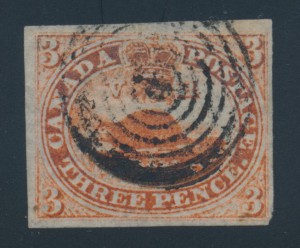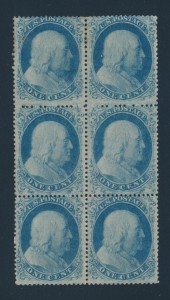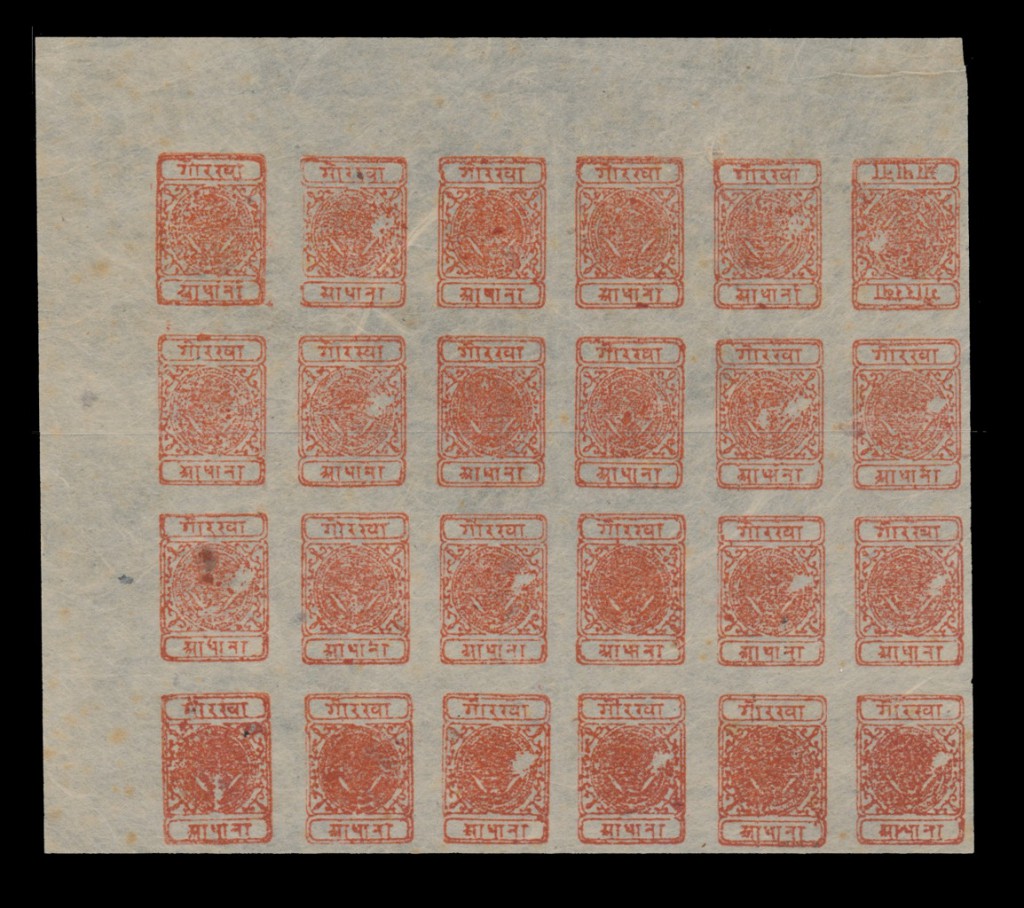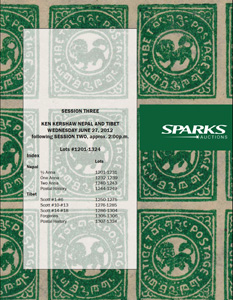 Lot 1 Canada #1 Used 1851 3d red Beaver, four full to large margins, just clear of outer frameline at bottom right, nice deep colour for the issue, bold 7-ring target cancel, very fine. Unitrade CV$1,600
Lot 1 Canada #1 Used 1851 3d red Beaver, four full to large margins, just clear of outer frameline at bottom right, nice deep colour for the issue, bold 7-ring target cancel, very fine. Unitrade CV$1,600
Auction #10 print catalogues have been mailed
We received the shipment of printed catalogues for our June 26-28th auction this afternoon and promptly delivered them to Canada Post. Canadian customers should receive theirs by the end of this week, USA early next week, and international by the end of next week.
Please contact us if you do not receive your catalogue in time to bid in the sale.
Lot 1401 — US #18, 20 in block of six
 Lot 1401 OG/NH USA #18, 20 1857 1c blue perf. 15½ Type I and Type II Combination block of six with two never hinged. Type II was produced from an altered die and when plate 12 was laid out, transfer rolls from both the original and altered die were used. This has a 2011 Philatelic Foundation certificate “unused, OG, block of 6 (2×3), positions 32-33/42-43/52-53R12, B/C/B reliefs, top and bottom rows Type II, centre row Type I, and we are of the opinion that it is genuine, previously hinged, the top left stamp with a small adherence on the reverse.” The block is fresh, without fault and the two middle stamps are never hinged (Scott 18 CV$4,200 for hinged and the earliest premiums for never hinged starting with the 1879 issues are more than 300%). An important classic block destined for an advanced collection. Scott CV$10,650
Lot 1401 OG/NH USA #18, 20 1857 1c blue perf. 15½ Type I and Type II Combination block of six with two never hinged. Type II was produced from an altered die and when plate 12 was laid out, transfer rolls from both the original and altered die were used. This has a 2011 Philatelic Foundation certificate “unused, OG, block of 6 (2×3), positions 32-33/42-43/52-53R12, B/C/B reliefs, top and bottom rows Type II, centre row Type I, and we are of the opinion that it is genuine, previously hinged, the top left stamp with a small adherence on the reverse.” The block is fresh, without fault and the two middle stamps are never hinged (Scott 18 CV$4,200 for hinged and the earliest premiums for never hinged starting with the 1879 issues are more than 300%). An important classic block destined for an advanced collection. Scott CV$10,650
Lot 1204 — Nepal Half Anna red orange unused block of 24 with invert pair
We begin our auction highlights with the catalogue cover item, a true rarity and showpiece.
 Lot 1204 Nepal #11, 11a 1917 Half Anna red orange unused block of 24 with invert pair, 6th Setting with Dr. W.C. Hellrigl 2004 certificate to quote “ imperforate on medium native paper, unused block of 24 from the upper left corner of the sheet (pos 1-6, 9-14, 17-22, 25-30), with an inverted cliché on pos 6…This is the second largest unused multiple of this stamp, the largest being a half sheet of 32. All unused copies derive from the two sheets. The multiple described here is ex Heddergott collection…The multiple is in fine condition. The right foxing spots in the margin are typical of this issue and they occur on all other multiples cut from the two known sheets…genuine in all respects.” The block of 32, referred to in the certificate, was sold by Robson Lowe in 1967 and has not been seen since. This block sold in the Heddergott sale in 1980. This block has two vertical creases. One is between the third and fourth row, the other is a pre-printing crease through the fourth row. Mint tête-bêche pairs of this stamp are unpriced and are world-class rarities, Hellrigl: “The total number of tête-bêche pairs known amounts to less than one dozen, the majority being used. Scott catalogue value is for 24 singles with the invert pair at twice two singles. Scott CV$49,000.
Lot 1204 Nepal #11, 11a 1917 Half Anna red orange unused block of 24 with invert pair, 6th Setting with Dr. W.C. Hellrigl 2004 certificate to quote “ imperforate on medium native paper, unused block of 24 from the upper left corner of the sheet (pos 1-6, 9-14, 17-22, 25-30), with an inverted cliché on pos 6…This is the second largest unused multiple of this stamp, the largest being a half sheet of 32. All unused copies derive from the two sheets. The multiple described here is ex Heddergott collection…The multiple is in fine condition. The right foxing spots in the margin are typical of this issue and they occur on all other multiples cut from the two known sheets…genuine in all respects.” The block of 32, referred to in the certificate, was sold by Robson Lowe in 1967 and has not been seen since. This block sold in the Heddergott sale in 1980. This block has two vertical creases. One is between the third and fourth row, the other is a pre-printing crease through the fourth row. Mint tête-bêche pairs of this stamp are unpriced and are world-class rarities, Hellrigl: “The total number of tête-bêche pairs known amounts to less than one dozen, the majority being used. Scott catalogue value is for 24 singles with the invert pair at twice two singles. Scott CV$49,000.
The Ken Kershaw Collection Of Nepal & Tibet
As a schoolboy Ken Kershaw was able to demonstrate an encyclopedic knowledge of all British flora. His scholarship and phenomenal memory served him well in his academic career. Field trips around the world, and especially in the Arctic, led to his publications on lichens which have set a scholarly gold standard.
After early retirement his natural curiosity and training in study and classification served him well as an entrepreneur and later as a restaurateur.
 A return to his boyhood hobby has resulted in about a dozen research books, notably the five volume study of Canada’s Three Penny Beaver. Ken is intrigued by difficult philatelic problems. He enjoys the challenge of first identifying and then confirming a plating study. Nepal and Tibet introduced the problem of confirming printing flaws as constant, progressive, or non-constant. To do this he obtained as many large blocks and sheets from as many settings as was practical. Although Ken is still working with the pashupati issues the time has come to move on to other pursuits.
A return to his boyhood hobby has resulted in about a dozen research books, notably the five volume study of Canada’s Three Penny Beaver. Ken is intrigued by difficult philatelic problems. He enjoys the challenge of first identifying and then confirming a plating study. Nepal and Tibet introduced the problem of confirming printing flaws as constant, progressive, or non-constant. To do this he obtained as many large blocks and sheets from as many settings as was practical. Although Ken is still working with the pashupati issues the time has come to move on to other pursuits.
NOTES ON THIS AUCTION
Especially in the case of Nepal, the native laid paper has characteristic inclusions and lack of uniformity such that there may be no stamp in existence that merits the most exacting quality standards of some collectors. We have tried to describe all faults which occurred after manufacture as well as the grossest of the faults during manufacture of this paper. A grade of very fine was used when it occurred to us that a particular sheet or block had better than normal overall appearance.
Nepal is organized by denomination. Tibet is organized by Scott number. We refer to tete-beche stamps as inverts, a term which is more commonly used in the literature of the “Himals.”
Ken’s unpublished five-volume study THE HALF ANNA ISSUES OF NEPAL consists of more than twelve hundred pages of careful documentation of the Nepal issues. These books can be downloaded below and then read on your computer, eReader, or tablet device.
VOLUME I: The settings, definitive flaws, and plating criteria (11MB)
VOLUME II: Plating the flaws in the spandrels and central oval frame (30MB)
VOLUME III: Plating the frame flaws (19MB)
VOLUME IV: Plating the flaws in the central oval (10MB)
VOLUME V: Plating the flaws correlated with the double Khukris (15MB)
